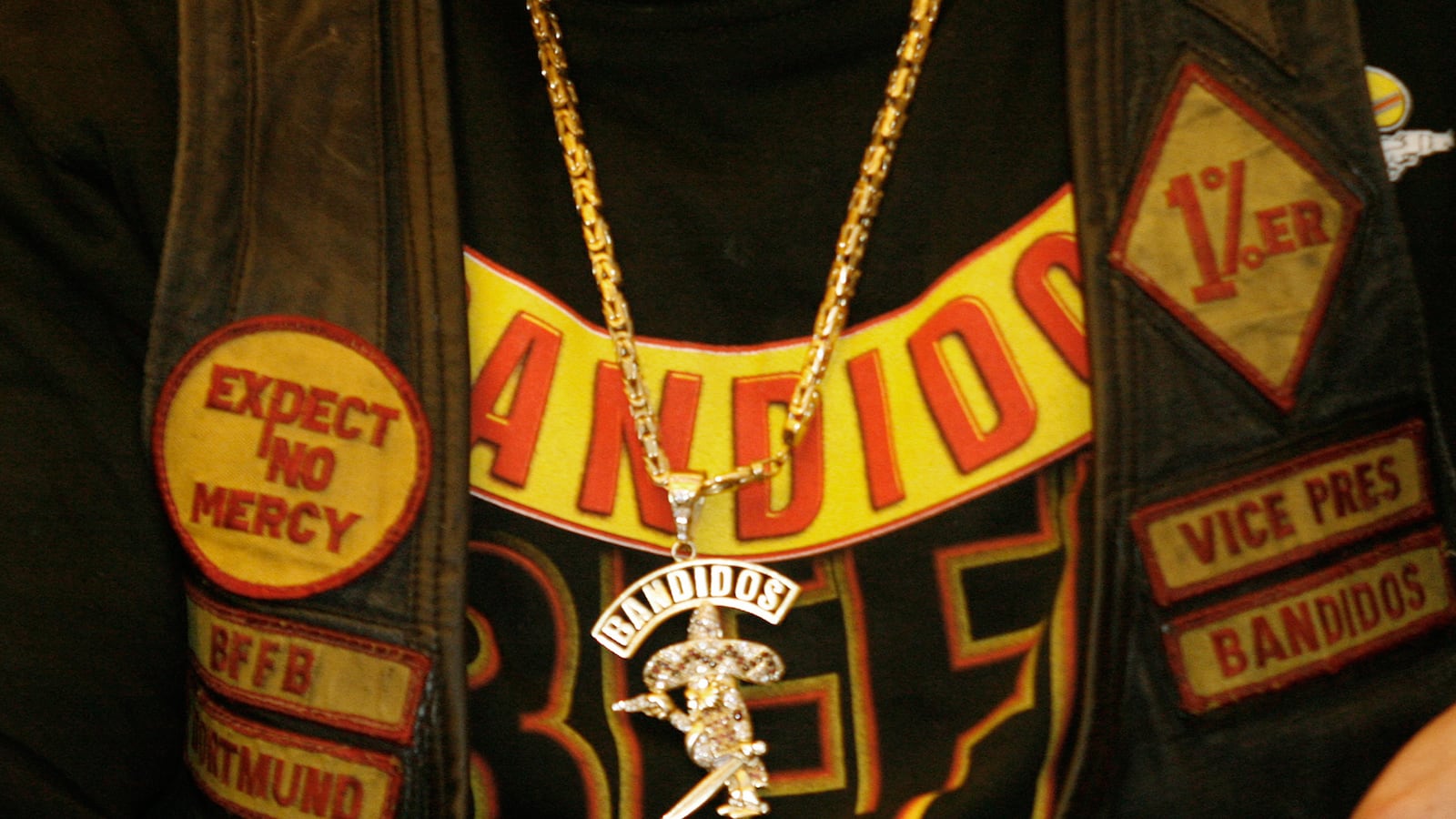A crew of bikers clad in black leather vests had descended on their buddy’s farm in southwest Ontario. They called themselves the No Surrender Crew, and they were the Canadian chapter of the outlaw motorcycle gang the Bandidos. It was April 8, 2006.
In the past, these roughnecks had greeted each other as “Brother.” But on that April day, they met the ultimate betrayal: having their patches pulled and being kicked out of the international motorcycle club.
Hours later, they were shot dead by their own brothers, their dead bodies stuffed into vehicles on a nearby road. Their murderers accused Jeff Pike, the Bandidos’ “El Presidente” himself, of giving the order.
“If I was the prosecutor in Ontario, I would have charged him,” Clay Powell, the attorney for Wayne Kellestine, the man who hosted the massacre meet at his farm, told The Daily Beast in a phone interview. “But I guess you need a lot of resources for that to happen.”
But Pike said at the time that he didn’t order anything more than stripping the Canadian chapter of its patches.
Pike is the global leader of the Bandidos, a biker gang that authorities allege was involved in Sunday’s bloody shootout in Waco, Texas, that left nine people dead and 18 injured with bullet and stab wounds.
What appears to have been a scheduled coalition meeting to draw together multiple motorcycle clubs instead went south fast in a fusillade of bullets fired and bodies dropping dead.
The brawl began at 12:15 p.m. inside Twin Peaks, a restaurant known for cleavage-baring waitresses and biker clientele, and spilled out into the parking lot. Police say the outlaws attacked each other before turning their firepower on officers. The cops shot back, killing four of the bikers, law enforcement sources said.
Law enforcement said the bloodbath was sparked by rival biker gangs the Bandidos and the Cossacks. Footage from the scene also showed riders with Scimitars insignia.
An informant who goes by the name “Charles Falco” told CNN a turf war is brewing in Texas.
“The Bandidos are the biggest motorcycle gang in Texas, and they don’t allow other motorcycle gangs to enter that state,” Falco said. “They will allow other motorcycles clubs to exist, but they’re not allowed to wear that state bottom rocker. If they do, they face the onslaught of the Bandidos.”
The Cossacks reportedly were wearing the bottom rocker, or a state name indicating territory or a club’s origin on the back of a biker’s vest. But a Bandido member from the Fort Worth, Texas, chapter told The Daily Beast nobody's warring over dibs to don the Lone Star state by name in its colors. "Everybody's been wearing Texas rockers for years," the biker, who requested anonymity, said.
On Sunday night, federal agents and local cops were still sweeping the crime scene.
The next morning, Waco police department announced the arrests of 170 people and paraded a cluster of mugshots to the media. The bikers’ bail was set at $1 million apiece.
In the rogues’ gallery were a slew of aging bikers with slicked back white hair and goatees.
One Bandido, Marshall Mitchell, 61, is a grandfather who owns a car dealership, attorney Kent Schaffer told The Daily Beast.
Schaffer, a Houston attorney who’s represented Bandidos in criminal cases for 32 years, said he knows Mitchell and can “guarantee he didn’t go to Waco looking for trouble.”
“The Bandidos don’t look for trouble, but they don’t back away from it,” Schaffer said. “They’ve always been made to look like the bad guys. There may have been a time when some of this was true, but now it’s a totally different day and age.”
Schaffer said Sunday’s melee was a fight that got out of hand rather than a case of organized crime.
“It’s just unfortunate this dispute came to that,” Schaffer told The Daily Beast. “The Cossacks are a group of fairly new bikers. I’m sure they thought the Bandidos were older and it’s easy to shove them around. It probably didn’t work out as easy as they’d hoped.”
On CNN Monday afternoon, veteran Bandidos member Jimmy Graves claimed the Cossacks were behind the massacre and sang the praises of his club. The Bandidos’ website features feel-good Easter parties and toy drives in Europe, he said.
“We are not a gang. We do not do gang things. We are not affiliated with gangs,” Graves said. “They’re saying lies on TV and telling everybody that Bandidos are after police officers. That’s never been.”
In an interview with The Daily Beast, one member of the Bandidos’ Fort Worth chapter said he and his brothers didn’t join in at the Twin Peaks restaurant. “I was at church when it happened,” said the Bandido member, who requested anonymity.
When asked what triggered the violence, the Bandido member said it wasn’t a long-standing feud with any of the other clubs. “As far as I know it was an isolated incident,” he said.The Bandidos have 2,500 members spread across the United States and 13 other countries, and are considered one of the two largest outlaw motorcycle gangs in the U.S., behind only their arch rivals, the notorious Hells Angels from California.
The club was founded in Houston in 1966 by disgruntled Vietnam veteran Donald Chambers and named after Mexican revolutionaries who answered to no one. The Bandidos’ motto: “We are the people our parents warned us about.” An initiation rite included members urinating, vomiting, and defecating on a new member’s vest, Texas Monthly reported in a 2007 profile.
Since the club’s founding, Bandidos members have been involved in deadly brawls and arrested for drugs, racketeering, and even murder.
In 2004, San Antonio Bandido Ricky Merla stabbed boxing phenom Robert Quiroga 17 times and left him for dead. Merla was convicted of murder, received a 40-year prison sentence, and was expelled from the club.
“I am a natural born outlaw, OK, I can’t defend myself?” an unrepentant Merla told News 4-WOAI in San Antonio four years later, adding, “I’m an outlaw. What’s the definition of an outlaw? I’m a true outlaw. I’m not like those guys running around over there right now, man.”
In 2005, 26 Bandidos members were arrested for a litany of charges that included drug trafficking, guns, kidnapping, and extortion. The feds brought the charges under the Racketeer Influenced and Corrupt Organizations (RICO) Act—the same penalties used to prosecute the Mafia.
George Wegers, the former Bandidos national president, spent 20 months in jail after he and some other members reached a plea agreement, the Seattle Times reported. Wegers’s attorney Jeffrey A. Lustick told The Daily Beast the federal case wasn’t strong and that “as soon as the government got into the case, they wanted to get out.”
A year later, cyclist Anthony Benesh, 44, was killed by a sniper as he was leaving an Austin pizzeria with his girlfriend and two sons. Benesh had been trying to launch a Hells Angels chapter in the city. Police had few leads, but an Austin Police Department detective said, “Everything...has been pointing toward the Bandidos.”
Pike, a 59-year-old father of two who lives 40 miles north of Houston, slid into the Bandidos presidency after Wegers pleaded guilty to the RICO charges.
Court records show Pike was arrested on weapons and assault charges in the 1980s and ’90s in Harris County, where he lives.
After the high-profile Benesh and No Surrender Crew murders, police became even more suspicious of Pike, who apparently trademarked the Bandidos name in 2010.
But the Bandidos president told Texas Monthly editor Skip Hollandsworth the media was blowing the club’s transgressions out of proportion. “I’m just a clean-cut American guy who loves riding his motorcycle,” he said. “You’d be surprised. I’m almost always in bed by 10 p.m. Come on down, I’ll talk to you.”
Aside from a heart-to-heart in Hollandsworth’s feature, Pike has kept a low media profile, and little is known about him. He told the magazine he dropped out of high school and moved from California to Texas in 1973, “partly because the drinking age was 18.” When he was 20, he bought a Harley and acquainted himself with Bandidos members in Houston.
Local police became suspicious of him, he said, after seeing surveillance footage of him wearing the “Expect No Mercy” patch on his vest, which is given only to members who have spilled blood to defend the Bandidos.
Pike, who makes a living privately restoring vehicles, said cops wanted to pin crimes on his club, and he denied any involvement in the Austin and Ontario rubouts.
“Why can’t the feds just accept the fact that we’re a bunch of old bikers who love to get together and have some fun?” Pike told Hollandsworth. “Why don’t they start chasing the real criminals, like those kids in street gangs who scare the shit even out of me, instead of following us everywhere we go, tapping our phones, and trying to destroy us with a bunch of made-up charges?”







